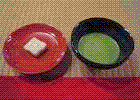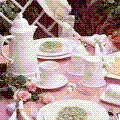 Tea comes in more varieties than you may suspect. However, based on the way the leaves are processed, all teas are divided into four basic types: black, green, oolong and the very rare white.
Tea comes in more varieties than you may suspect. However, based on the way the leaves are processed, all teas are divided into four basic types: black, green, oolong and the very rare white.
Black teas are oxidized; this means that the leaves are exposed to the air for a precise length of time in order to allow natural chemical reactions to occur. These reactions change the leaves’ color from green to copper and intensify their flavor until it is rich and complex. Earl Grey, English Breakfast and Darjeeling are some examples of black teas.
Green teas are not oxidized; they are merely withered and dried. Generally subtle and pale, they are a wonderful accompaniment to Oriental foods. Because of their slightly bitter taste, they are sometimes best enjoyed after a very sweet dessert. Green teas include Lung Ching, Bancha and Sencha.
Oolong teas are a combination of green and black leaves. They are partly fermented and stronger than green teas, but are more delicate than the fully fermented black teas. Black Dragon and Pouchong (Pao-Chung) are a couple of oolong teas.
China whites, produced exclusively in China and highly prized, are simply steamed and dried, providing light, fragrant brews. These are usually taken without a meal, and are available from only the best specialty stores and importers. White teas include Flowery White Pekoe, Silver Needles and Noble Beauty.
Incidentally, for those who may be wondering, herbal teas are often called “tisanes” or “infusions” by purists, who hate to see them confused with teas from the tea plant. Chamomile and Peppermint are just two of the many herbal teas available today.
Brewing the Perfect Cuppa
Even the very finest tea chosen with great care and precision can be a great disappointment if improperly brewed. Whether served from cups of white jade or heavy mugs, a perfect and pleasurable cup of tea is within reach of those who follow a few simple steps:
1. Fill an empty kettle with fresh cold water that has flowed freely from the faucet for a minute or two; running the water allows it to become fully aerated, providing the most flavorful tea. If the water is too full of minerals such as iron, use bottled water. Place the kettle on the burner and bring to a rolling boil over medium heat.
2. While the water is heating, pour hot water into an earthenware or porcelain (or even glass) teapot with a loose-fitting lid. Don’t use aluminum as it leaves a taste in the tea infusion.
3. When the water is about to boil, empty the teapot and measure into it one teaspoonful of tea per cup, plus the requisite “one for the pot.” The best tea is brewed from whole, loose leaves. “Most tea bags are stale,” says John Harvey of Harvey & Sons Tea importing in Salisbury, Connecticut. Whole tea leaves are not only fresher and of better quality, they also produce a more complex beverage as the leaves unfurl. Loose tea will keep for up to a year if stored properly in an airtight container to protect it from moisture and odors.
 As soon as the water in the kettle boils, turn off the heat. Do not over-boil the water or it loses oxygen and even the finest tea will taste flat. On the other hand, do not under-boil the water. The water must be at a full rolling boil to release the full flavor from the leaves, otherwise the result will be a weak brew. Bring the pot to the kettle, never the kettle to the pot. This ensures that the water temperature is closest to boiling.
As soon as the water in the kettle boils, turn off the heat. Do not over-boil the water or it loses oxygen and even the finest tea will taste flat. On the other hand, do not under-boil the water. The water must be at a full rolling boil to release the full flavor from the leaves, otherwise the result will be a weak brew. Bring the pot to the kettle, never the kettle to the pot. This ensures that the water temperature is closest to boiling.
4. Pour the water over the tea leaves. Put the lid on the pot, cover and let steep for five minutes. If brewing by the cup, use the saucer to cover the cup and retain the heat.
5. To make a stronger tea, increase the amount used rather than lengthen the brewing time. Strength of tea cannot be judged by color; some tea leaves brew light while others make a dark liquid. For small leaves such as English and Irish Breakfast blends and Assam teas, steep for three minutes. Medium leaves of Ceylon, Breakfast, Orange Pekoe, and Queen Mary are best when brewed for four to five minutes. Large leaves such as Oolongs, Jasmine and Earl Grey should brew for five to six minutes. Don’t leave the tea leaves in for more than six minutes or the result will be a bitter-tasting drink.
6. Gently stir the tea before pouring into the cups. If the teapot has an effective built-in strainer, pour directly into the cup. If not, pour into the cup through a strainer. A teapot of hot water standing by may be used to dilute the brew to the guest’s preference. If all of the tea is not to be served immediately, pour off the brewed tea into a separate heated pot as continued steeping will make it taste heavy and bitter.
7. When using tea bags, squeeze them gently before removing. Generally, tea bags should be steeped for less time because they are comprised of lower-grade tea, which brews quickly.
Tea Trivia (or: God Save the Queen…from Cracked China!)
The British Standards Institute has proclaimed that milk is best poured before the tea, though this is debated by some tea lovers. Those in favor say that the hot water scalds the milk, which brings out the tea’s flavor. (And they never use cream, as it masks the tea’s taste.) Others have speculated that the milk-first theory prevents the china from cracking in reaction to the boiling water. However, Queen Elizabeth II reportedly enjoys her tea by adding the milk afterward. Oh, those reckless royals…
Iced Tea
To most Americans, only one distinction counts when it comes to tea: whether it is served hot or cold. About 50 percent of Americans drink tea, but 80 percent of that is Iced Tea–more than two billion gallons annually.
Of course, most of this might be in the form of Snapple, or any of the other more than 200 ready-to-drink products labeled as “iced tea” which have now become a staple of the 1990s beverage market. Iced tea is not a new concept, however; it originated in the 1860s in the South (where it is as much a part of the social life as afternoon tea is in England), and gained national popularity after being promoted at the 1904 St. Louis World’s Fair.
Today iced tea and coffee drinkers outnumber wine drinkers at lunchtime by a wide margin and have even pushed bottled waters into the background. In addition, several French chefs are now serving iced tea with the same attention to detail that they give everything else in their restaurants. For example, Jean-Georges Vongerichten is reportedly icing traditional French teas at his acclaimed Manhattan bistro, Jo Jo and promoting an extensive array of Oriental iced teas at his Asian-inspired restaurant, Vong.
The variety of new iced teas leaves enormous latitude for creative chefs. For instance, Mark Spangenthal of New York City’s Markham is using seasonal fruit purees to flavor his tea. Scott McVean of Pain du Monde Bakery in Newport Beach, California has been captivated by the delicious taste of Tazo teas (with such names as Calm, Passion and Awake) from Portland, Oregon, the formulas for which have recently been rediscovered by a team of archeologists and tea scholars.
The English Afternoon Tea
At four o’clock each day, the British are renowned for stopping everything with a sigh of relief to enjoy afternoon tea.
Traditionally, a formal afternoon tea is performed according to certain rules of etiquette. At intimate gatherings the tea server (usually the hostess) pours the tea while seated with her guests. The server first asks, “Sugar, one lump or two?” then places the sugar in the cup using specially designed sugar tongs, if available. Then she asks, “Milk, or lemon?” The milk is poured before the tea, and for the lemon-takers, a plate garnished with thinly sliced lemons is offered with a small fork. After handing the cup to the guest, hot water is offered for those who like a weaker infusion.
Once everyone is served, the guests select traditional tea fare from the table or a tiered cake stand. The goodies include crumpets slathered with butter, tea breads brimming with fresh and dried fruits, dainty well-trimmed tea sandwiches, tall stand cakes, flaky scones, tart jams, lemon curds, small cookies, etc. Each guest takes a napkin, folded on a small plate, and a butter knife for spreading jam, cream or sweet butter.
At bigger parties a guest, instead of the hostess, sometimes serves the tea, and the dainties are then displayed from long trestle boards set with silk or lace runners, or from small tables scattered about the room. In this way, guests can help themselves and sit wherever they like. It takes some practice to balance a full cup, saucer, plate piled high with cakes and sandwiches, knife and napkins, but it is said that dropping crumbs and spilling tea are initiation rites and should be considered part of the enjoyment of the ceremony.
The English High Tea
 High tea was conceived in the late nineteenth century as the workingman’s supper; it is generally a family meal served early in the evening. There is a widespread misconception that high tea means formal tea, but that is far from the case; the high tea is designed to refuel the body that has labored long and hard in sometimes less-than-agreeable environments such as coal mines or factories.
High tea was conceived in the late nineteenth century as the workingman’s supper; it is generally a family meal served early in the evening. There is a widespread misconception that high tea means formal tea, but that is far from the case; the high tea is designed to refuel the body that has labored long and hard in sometimes less-than-agreeable environments such as coal mines or factories.
All of the foods to be served are set on the table right at the beginning of the meal. Typical fare includes freshly baked bread warm from the oven (Sally Lunn, hearty wheat, oat or barley breads), Rarebit (a savory cheese dish served over toast), Cornish pasties filled with meat and vegetables, hot cross buns, and all the sweeter baked goods the table can handle. Some traditional high tea sweets include seed cake, shortbread, crumbled cookies named “Fat Rascals,” and almond cakes known as “Maids of Honor.”
By by Tarla




